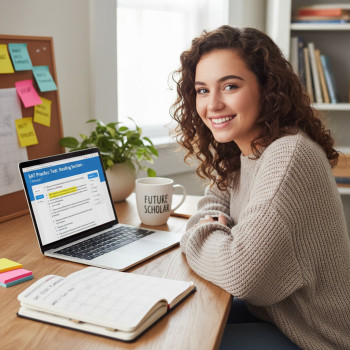Why the Official Digital SAT Practice Tests Matter More Than You Think
Picture this: test day arrives, your Bluebook app opens, the proctor gives instructions, and the first question pops up. For a lot of students, that slice of time between the proctor’s “begin” and the first couple of questions is when nerves either settle or spiral. The best way to shrink that gap between nervous and confident is simple—practice the way you’ll take the test.
That’s the core reason why official Digital SAT practice tests are not optional extras; they’re the backbone of any smart prep plan. These tests mirror the delivery, tools, timing, and adaptive behavior of the real exam. Practicing with them is like rehearsing on the exact stage where you’ll perform.
Not all practice is created equal
There are thousands of SAT-like questions online and dozens of practice books. Many of them are useful. But “SAT-like” is not the same as “SAT.” Official digital practice tests give you two huge advantages: fidelity and feedback. Fidelity means you’re practicing under conditions that match the actual test—same navigation, same highlighting and annotation tools, same on-screen calculator rules, and the same adaptive section structure. Feedback means official explanations, scoring, and detailed item-level analysis (when you use official platforms that provide it), so you know precisely which skills to build.
What makes the official Digital SAT practice tests different?
- Exact test environment: The Bluebook testing app simulates the real digital interface, including timers, item formats, and embedded tools.
- Adaptive format experience: Many practice tests show how sections adapt to your performance—practicing this helps you avoid surprises about difficulty shifts.
- Official scoring and explanations: Questions come from the same item pool writers and are vetted for alignment with SAT standards.
- Accommodations and assistive tech practice: If you use approved accommodations, practicing with the official app helps you configure and grow comfortable with the exact setup.
In short: the official practice tests provide the most reliable rehearsal for what you’ll encounter on test day.
Photo Idea : A screenshot-style mockup showing a student practicing in the Bluebook app on a laptop, with highlighted tools and a timer visible
How to use official practice tests strategically (not just once)
Taking a full-length practice test is a big investment of time, focus, and energy—and it should be treated like a practice performance. Here’s a step-by-step approach to get the most mileage out of each official practice test.
1. Schedule realistic practice dates
- Take your first full official test at least 6–8 weeks before the real test. This gives you time to diagnose weaknesses and work on them.
- Take a second one 10–14 days before test day as a final simulation and to lock in pacing strategies.
2. Simulate test day conditions
Choose a quiet space, use the same device you’ll test on (or at least the same OS and screen size), turn off notifications, and keep a timer visible. Wear what you’d wear on test day; small comforts matter. Practicing under realistic conditions trains your focus and helps reduce surprises.
3. Treat it like a performance, not a scavenger hunt
Many students rush through practice tests hunting for hard problems to “conquer.” Instead, focus on consistent pacing, clean answer-marking habits (digital flags, notes), and mental stamina. Your goal is to complete sections with the same strategy you’ll use on test day.
4. Immediately review with a plan
The minute the test is done, you’ll want to review mistakes—not to punish yourself, but to learn efficiently. Effective review combines three things:
- Identify mechanical errors (timing, skipped questions).
- Classify content errors (algebra skill, passage inference, command of evidence, grammar rules).
- Note strategic errors (bad guessing patterns, over- or underuse of the calculator, misreading multi-part questions).
5. Build micro-practice from the analysis
Turn the review into short focused practice: 20–40 minute targeted drills on the weakest question types, then return to mixed practice. If you make the same mistake twice, isolate the root cause and write a tiny checklist to use during the next practice test.
How to analyze your official practice test results
Analysis is where the real score gains happen. A practice test without a rigorous post-test plan is like running a race and skipping the cooldown. Official practice platforms often provide section scores, percentiles, and item-level feedback—use them.
Useful analysis categories
- Accuracy by question type: Literal comprehension, evidence-based reading, algebraic manipulation, multi-step problem solving.
- Timing distribution: Which passages or problem sets took extra time?
- Mistake taxonomy: Was it content, careless error, or strategy failure?
- Progress tracking: Compare results across practice tests to ensure gains are real and not random.
Example of a simple analysis table
| Section | Raw Score | Time Spent / Question (avg) | Common Errors | Next Steps |
|---|---|---|---|---|
| Reading | 20/26 | 1:55 | Main idea vs detail confusion | Practice passage summarization; drill question stems |
| Writing & Language | 18/20 | 0:48 | Grammar rules on modifiers | Targeted grammar sets; error logs |
| Math (No Calculator) | 16/20 | 1:40 | Algebraic manipulation mistakes | Step-by-step algebra review; timed drills |
| Math (Calculator) | 22/24 | 1:15 | Rounding/units errors | Calculator strategy practice; check units habit |
This table is a simple example—but creating a personalized version will point you to the skills that merit the most work.
How adaptive practice tests change strategy
The digital SAT’s structure includes adaptive elements: the test adjusts to your performance. That changes the calculus for how you approach questions. When a section adapts to your level, the emphasis shifts from trying to get as many hard questions right to maintaining steady accuracy and solid pacing.
Key adaptive test-taking tips
- Accuracy matters: A few careless mistakes can drop you into a lower-difficulty band, which changes the mix of later questions.
- Don’t chase flashier hard questions: The goal is steady performance across items of varying difficulty.
- Practice the adaptive feel: Official digital practice tests reproduce adaptation; the more you practice there, the less surprise on test day.
Timing strategies for the Digital SAT
Time is ruthless: run out and you leave points on the table; move too quickly and you make careless mistakes. Official practice tests let you experiment with timing strategies and find the sweet spot that balances speed and accuracy.
Practical timing drills
- Passage time targets: Set a pace for each reading passage (e.g., 12–14 minutes per passage) and practice hitting it while maintaining accuracy.
- Math chunking: Break math sections into blocks—do an initial pass to knock out straightforward items, then flag the harder ones for a second pass.
- Simulated emergencies: On practice tests, deliberately start a section 5 minutes late to practice accelerated pacing under pressure. You’ll learn which question types to drop and which to prioritize.
Using practice test analytics to build a study roadmap
Official practice platforms often provide analytics. Translate those numbers into a weekly study roadmap:
- Week 1–2: Diagnostic test + foundational review (algebra essentials, grammar rules, passage strategy).
- Week 3–5: Targeted practice based on the diagnostic—30–45 minutes daily on weak areas + one adaptive practice section twice weekly.
- Week 6: Full official practice test under test-day conditions, then two weeks of fine-tuning.
- Final 10–14 days: One full official practice test each week, short drills, and taper for mental rest the last 48 hours.
This roadmap is flexible—some students may need more content review while others focus on timing and strategy. The point is to let official practice test data guide your priorities.
How official practice tests help with accommodations and assistive tech
If you use approved accommodations, practicing in the official environment is indispensable. The platform allows you to toggle many assistive features during practice so you can confirm settings, get comfortable with navigation, and adjust workflows. Use practice tests to verify that your reading tools, text-to-speech, or extended timing workflows run smoothly on your device.
Common mistakes students make with official practice tests (and how to fix them)
- Taking them like a treasure hunt: Students sometimes use practice tests only to find challenging questions. Instead, treat them as full rehearsals—practice pacing, breaks, and mental stamina.
- Skipping thorough review: It’s tempting to look only at the score. Don’t. Drill down into each missed question until you can explain exactly why the right choice is right and why your choice was wrong.
- Ignoring device readiness: Test-day device issues are avoidable. Install Bluebook, check updates, and practice logging in and navigating the app multiple times before test day.
- Over-practicing without variety: Repeating the same test or question type can create false confidence. Use the range of official practice tests to get diverse content and question formats.
How to combine official practice tests with targeted tutoring
Official practice tests reveal growth areas; tutoring helps you close those gaps. One-on-one tutoring can translate test analytics into tailored lesson plans: targeted skill-building, strategy coaching, error-log analysis, and accountable practice. For many students, that combination—official practice for diagnosis and adaptive realism, plus personalized tutoring for targeted improvement—is the fastest path to better scores.
For example, Sparkl’s personalized tutoring offers 1-on-1 guidance, tailored study plans, expert tutors, and AI-driven insights that can interpret practice-test analytics and convert them into specific daily drills. When official practice tests flag, say, inconsistent performance on evidence-based reading questions, a tutor can design short micro-lessons and practice sets to remedy that precise issue—then the student returns to another official practice test to measure real improvement.
Practical checklist for each official practice test session
- Choose a quiet, test-like environment.
- Use your test-day device and charge it fully.
- Set up Bluebook and close other programs/notifications.
- Time the test strictly and avoid external help.
- After completion, immediately export or record your raw results and flagged items.
- Create a short action plan: one content skill to study this week, one strategy to adjust, and one timing target.
How many official practice tests should you take?
Quality beats quantity. Rather than aiming for a fixed number, aim for meaningful cycles of test → analysis → targeted practice → retest. That said, a practical guideline is:
- At minimum: two full official practice tests—one early and one near test day.
- Ideal: three to five tests spaced over your study calendar, with focused, non-trivial review after each test.
Follow each test with 1–3 weeks of concentrated work on the weaknesses it reveals. If you’re working with a tutor or service like Sparkl, coordinate those practice tests into your tutoring schedule so each test informs lesson planning and progress measurement.
Real-world examples: small changes that yield big score gains
Students often overestimate the amount of content needed to raise scores and underestimate the power of strategy changes. Here are a few concrete examples:
- Reading passage labeling: A student began quickly jotting two-sentence summaries for each passage before answering. That small change improved passage question accuracy by converting scattered notes into a reliable anchor for inference questions.
- Calculator discipline: Another student relied on the calculator for simple arithmetic and lost time. After practicing on official tests and following a tutor’s plan to do mental math when possible, the student shaved 20–30 seconds per math problem and regained time to revisit tougher items.
- Flag-and-return habit: Using the app’s flagging feature consistently reduced second-pass time because the student stopped wasting effort revisiting solved questions.
How to stay mentally fresh between practice tests
Burnout is real. Official practice tests are intense and can be draining if done too frequently. Use these habits to preserve focus while making real progress:
- Balance heavy practice days with lighter review days: one full test, two focused study days.
- Use spaced repetition for content mastery—short daily reviews beat marathon cramming.
- Build non-academic routines: sleep, exercise, and short mindfulness breaks support cognitive performance.
Final thoughts: practice smart, not just hard
Official Digital SAT practice tests are your best rehearsal for the real thing. They give you an authentic testing environment, high-quality questions, and actionable analytics. But tests alone don’t create improvement—intentional review and targeted practice do. Combine the fidelity of official practice tests with strategic analysis, micro-practice, and, when useful, personalized support.
If you want to supercharge your prep, consider pairing official tests with tailored tutoring. Programs that offer 1-on-1 guidance, adaptive study plans, and data-informed coaching (like the individual tutoring and AI-driven insights provided by Sparkl) can convert the raw diagnostics from practice tests into measurable score gains. Use the tests to show you where to focus, then use targeted practice and coaching to get you there.
In the end, the Digital SAT rewards students who practice the right things in the right way. Treat the official practice tests as rehearsals: simulate the conditions, analyze honestly, and train deliberately. Do that, and test day will feel less like an unknown and more like one more run-through—this time with a real audience and a real score on the line.














No Comments
Leave a comment Cancel